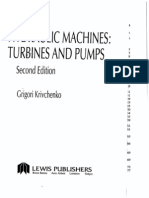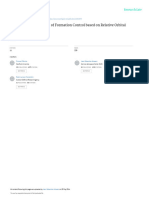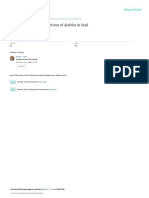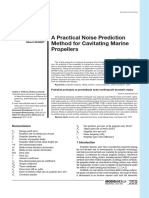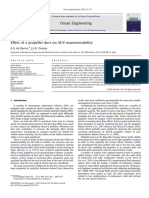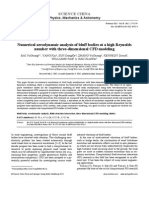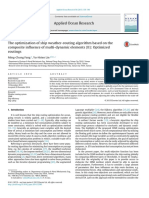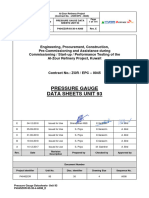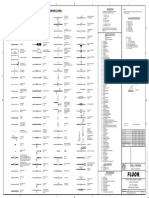Badoe Simman2014
Badoe Simman2014
Uploaded by
Prasad PatilCopyright:
Available Formats
Badoe Simman2014
Badoe Simman2014
Uploaded by
Prasad PatilOriginal Description:
Original Title
Copyright
Available Formats
Share this document
Did you find this document useful?
Is this content inappropriate?
Copyright:
Available Formats
Badoe Simman2014
Badoe Simman2014
Uploaded by
Prasad PatilCopyright:
Available Formats
See discussions, stats, and author profiles for this publication at: https://www.researchgate.
net/publication/270587547
Comparison of various approaches to numerical simulation of ship resistance
and propulsion
Conference Paper · December 2014
CITATION READS
1 222
6 authors, including:
Charles Badoe Björn Windén
18 PUBLICATIONS 135 CITATIONS
Texas A&M University
29 PUBLICATIONS 124 CITATIONS
SEE PROFILE
SEE PROFILE
Artur K Lidtke Alexander Phillips
Maritime Research Institute Netherlands National Oceanography Centre, Southampton
40 PUBLICATIONS 316 CITATIONS 127 PUBLICATIONS 1,973 CITATIONS
SEE PROFILE SEE PROFILE
All content following this page was uploaded by Alexander Phillips on 30 November 2016.
The user has requested enhancement of the downloaded file.
COMPARISON OF VARIOUS APPROACHES TO NUMERICAL SIMULATION OF SHIP
RESISTANCE AND PROPULSION
Charles Badoe (Faculty of Engineering and the Environment, University of Southampton, UK)
Bj ̈ rn Wind ́ n (Faculty of Engineering and the Environment, University of Southampton, UK)
Artur K. Lidtke (Faculty of Engineering and the Environment, University of Southampton, UK)
Alexander B. Phillips (Faculty of Engineering and the Environment, University of Southampton, UK)
Dominic Hudson (Faculty of Engineering and the Environment, University of Southampton, UK)
Stephen R. Turnock (Faculty of Engineering and the Environment, University of Southampton, UK)
addressed by extracting the propeller induced
1. SUMMARY velocities at a plane upstream of the propeller.
The prediction of a ship’s wake field and its The work presented in this paper compares the
resistance and propulsion characteristics has ability of four different methods; Hough and Ordway
traditionally been centered on experiments; however, prescribed body force approach (i), two coupled
with the advancement in high performance RANS-BEMt models (ii) & (iii) and a discretized
computers, this can be achieved through the use of propeller approach, (iv), (hereafter referred to as
computational methods. An advantage of using CFD methods i-iv) to capture the resistance and
is its ability to provide insight into flow propulsion capabilities of a container ship with
characteristics close to the wall, which are difficult to experimental data from the SIMMAN Workshop on
obtain through experiments. The most interesting and Verification and Validation of Ship Manoeuvring
challenging aspect of using CFD in ship resistance Simulation Methods, (SIMMAN, 2014). For
and propulsion analysis is the influence of the methods (i), and (ii), two simulations each were
propeller action and the unsteady hydrodynamics of conducted; one included the effect of free surface [F]
the rudder working in the propeller wake. One and the other utilizing a double body approach [NF].
approach to address the problem is to adopt the Only one simulation was performed with method (iii)
sliding mesh approach to discretize the ship, and (iv) which included the influence of freesurface
propulsor and the rudder, (Carrica et al., 2011). This [F].
approach is the most suitable but due to the small The main focus here is a detailed analysis on the
time steps and high computational cost involved, prediction of the hull and rudder performance
simulations are often performed using representative resulting from the different levels of body force
propeller models or body force method. The level of propeller approximations. A comparison is also made
complexities in the body force propeller approach between free surface [F] and double body approach
varies from prescribing the body forces (Simonsen [NF] on the prediction of hull, propeller and rudder
2000), through to coupling a more complex propeller forces.
performance code which accounts for the non-
uniform inflow at the propeller plane, Phillips et al., The presented study is based upon the well-known
(2009). There are several computations using body KRISO container ship (see Larsson et al., 2010),
force propeller models reported in the literature. whose lines are shown in Fig. 1. The SVA hull
Simonsen and Stern, (2003) coupled a body force model built and tested at Force technology was used.
propeller model based on potential theory
formulation in which the propeller was represented
by bound vortex sheets on the propeller disk and free
vortices shed from the downstream of the propeller
to a RANS code to simulate the manoeuvring
characteristic of the Esso Osaka with a rudder.
Rijpkema et al., (2013) investigated the propeller- Fig. 1 Body plan and side profile of the KCS ship
hull interaction and the determination of the effective model, source: Fujisawa et al., (2000).
wake field using a hybrid RANS-boundary element The forces and moments data for the SVA hull were
(BEM) approach. The coupling between the RANS obtained as part of the SIMMAN 2014 Workshop on
and BEM was performed using an iterative coupling Verification and Validation of Ship Manoeuvring
between the velocity fields from both RANS and Simulation Methods, (SIMMAN, 2014). Test no
BEM computations and the force distribution on the 2a -1 was considered. The self-propulsion test was
propeller blades obtained from the BEM results. The carried out at Fn = 0.202 in the fully appended
most challenging aspect of the coupling strategy was configuration and the propeller rps was set at 14. Full
the determination of the effective wake used as input details of the experimental test conditions and data
for the BEM computation. Due to the presence of can be found at the SIMMAN 2014 website,
singularities at collocation point of the BEM panel, (www.smmman2014.dk).
the determination of velocities in the propeller plane
lead to unrealistic values, hence the problem was
2. THEORETICAL APPROACH A complete description of the methodology can be
found in Badoe et al., (2012).
2.1 RANS Formulation
2.4 BEMt propeller model and coupling
The flow generated around the three propeller methodology (method ii)
models, rudder and hull can be modeled by the
Reynolds Averaged Navier-Stokes equations. Within An existing BEMt code (Molland and Turnock,
the assumption of an incompressible fluid, the set of 1996) was modified and coupled to a RANS solver
equations may be written in the form: (the same solver as 2.2), whereby within the RANS
mesh the propeller is represented as a cylindrical
̅̅̅̅ domain with diameter equal to that of the propeller
[1] diameter, D and a length of 0.1D. The propeller is
̅ ̅̅̅̅̅ ̅̅̅̅ ̅ ̅ ̅̅̅̅̅̅̅
adapted to the hull wake by employing a sectorial
{ ( )} ̅ [2] approach where the propeller domain is sub divided
into a series of nC circumferential, and nR radial
where represents the Cartesian coordinates (X, Y, slices along the blade. An example of a BEMt mesh
Z) and are the Cartesian mean velocity is presented in Fig. 2. A complete description of the
components ( ̅̅̅̅ , ̅̅̅̅ , ̅̅̅). The Reynolds stress is methodology can be found in Badoe et al., (2014).
expressed as ( ̅̅̅̅̅̅̅ ) and must be modeled using an The simpleFoam solver, a steady state solver for
appropriate turbulence model. The SST k-ω model incompressible, turbulent flows and the
has been successfully used for this purpose of hull- LTSInterfoam solver, a local time stepping solver for
propeller-rudder interaction and wakefield analysis, two incompressible, isothermal immiscible fluid
(Larsson et al., 2010) making it a natural choice for using the VOF phase-fraction based interface
the study discussed herein. capturing approached in OpenFOAM were modified
to accommodate the coupling for the double body
2.2 Modelling and free surface simulations respectively.
Numerical solution of equations (1) and (2) was
carried out for all methods using the open source
RANS solver OpenFOAM, which is designed to
solve problems in mechanics of continuous
mediums; see Jasak (1996) for more details on
introduction and numeric used in OpenFOAM. The
RANS equations were solved using a cell centered
finite volume method (FVM). Discretization of the
convection terms was achieved using Gauss linear
second order upwind and the diffusion terms were
treated using the central difference scheme. The
SIMPLE algorithm was used for the pressure-
velocity coupling. In the case of the free-surface flow
computations, the PIMPLE algorithm was used for
pressure-velocity coupling and a vanLeer scheme Fig. 2 BEMt propeller mesh showing radial, nR,
with interface compression was used for the VOF and circumferential, nC, subdivisions.
and volume fraction discretization respectively. The 2.5 BEMt propeller model and coupling
pressure correction equation was under relaxed with methodology (method iii)
a factor of 0.3, which was found as a compromise
between stability and convergence speed. In method A coupled RANS-BEMt solver is created using the
(iv), first-order schemes were applied to the turbulent method described by Windén (2014). This as further
quantities, the convection term was discretized using discussed by Wind ́ n., (2013) presents the use of a
a first-second order approach. First order Euler time- modular framework for coupling a FV flow solver on
stepping scheme was utilized in conjunction with the an arbitrary mesh with an arbitrary body force model
PIMPLE algorithm to advance the unsteady solution. for the propeller. Here, the BEMt equations are
Two outer loops, each with two inner pressure loops, solved on a separate structured concentric mesh with
were run until the residuals converged to at least 1e-8 the background FV mesh being adapted to best fit
at each time step. around the hull. Interpolation from the FV mesh to
The simulation was initialized from a steady-state the concentric mesh is conducted to obtain the
naked hull solution and then ran for approximately propeller inflow and vice versa to obtain the body
10 propeller revolutions. The fields were averaged force distribution for the solution of the momentum
by employing a script which loops over the time equation.
directories, reads the field and then writes the Due to discrepancies in the assumptions in the
averaged field for any user specified time derivation of the RANS equations and those of the
requirement. BEMt theories used and due to the lack of detail in
2.3 Hough and Ordway prescribed body force the propeller model, the theoretical propeller induced
approach and coupling methodology (method i) velocities are not well matched with those obtained
from probing the RANS solution (Windén 2014). To
In this approach the impact of the propeller on the compensate for this, Windén (2014) created an ad
fluid is represented as a series of axial and tangential hoc correction which is valid for a particular
momentum sources. Their strength is then calculated propeller geometry. The axial inflow velocity “far
using the Hough and Ordway thrust and torque upstream”, i.e. with the propeller induced velocities
distribution, (Hough and Ordway, 1965). This subtracted is calculated as
closely matches the optimum distribution, Goldstein,
(1929). It has been used by others such as Simonsen, ( ) [3]
(2000) and Phillips et al., (2009) to replicate the
action of the propeller in several marine applications. where is the axial inflow factor.
Equation [3] is corrected for a finite number of 3. GRID GENERATION
blades using
Unstructured, predominantly hexahedral grids with
local refinements around no slip walls were used in
√ [4] the study. All grids were created using blockMesh
and snappyHexMesh utilities forming part of the
and OpenFOAM libraries. The grids were congregated in
the regions of the stern, bow, near the hull surface
and the free surface. Ten to twelve elements were
[5] used to capture the boundary layer of the hull and
rudder yielding an approximate y+ of 60 for the hull
( ( )
and 30 for the rudder. The total number of grids used
[6]
was approximately 8million for methods (i) and (ii)
( ) ) and 18 million for method (iii). For method (iv) a
mesh of 12.7 million cells was used to conduct the
where a is the axial inflow factor from the converged sliding mesh interface computation, with 4 million
blade element solution, K is the Goldstein correction used to discretise the propeller and the rest placed in
factor and r/R is the relative location along the blade. the vicinity of the hull and rudder. Fig. 4 shows the
mesh resolution for the stern for methods (iv) and (i
This correction allows for the propeller induced & ii) respectively.
velocities to be separated from the total wake at run-
time. This in turn allows the model to find a balance
between the thrust and the ships resistance in a single
run without the need for an iterative procedure as in
methods (i) and (ii). It also allows for the wake to be
unsteady and the resulting fluctuations of thrust and
torque to be studied.
The simulation is run in two steps. First the steady
wave pattern is allowed to develop. When the calm
water resistance is found, the propeller model is [a]
activated and the simulation is run until the
resistance, thrust and torque reach steady values.
Note that only one simulation is necessary per mesh.
With run-time removal of the propeller induced
velocities, there is no need to stop the simulation and
update the nominal wake as carried out in methods
(i) and (ii).
2.6. Discretized propeller approach (method iv)
[b]
The discretized propeller approach employs a sliding
grid provided by the arbitrary mesh interface (AMI) Fig. 4 KCS stern mesh; method (iv) shown in [a]
for non-conformal mesh regions. This technique and methods (i) & (ii) depicted in [b].
allows flow data to be exchanged across 4.1. Grid sensitivity
disconnected mesh domains which can either be
stationary or moving relative to one another. In the A sensitivity analysis has been carried out using
discussed context, it operates by projecting one of method (iii) with the inflow correction to find the
the sides of the interface on to the other and is used resistance and propulsion characteristics of KCS.
for handling rotating meshes. The AMI idea is based Three meshes shown in Table 1 are used. The BEMt
on a set of weighting factors that balances the fluxes grid size of 10x10x1 elements was used for all cases.
at the region interface. An example of the AMI The table also shows the size of the concentric mesh
interface for a propeller is shown in Fig. 3. The used to perform the BEMt calculations, how many
drawback to this approach is that it is FV cells are inside the propeller disk and how much
computationally much expensive since the full of the total clock time is spent on propeller
transient flow field needs to be resolved. Moreover modelling. This percentage includes mapping, data
the cell count required also increases as the fine handling as well as solving the specific equations.
detail of the propeller needs to be resolved. This The predicted total resistance as seen from Table 2 is
becomes particularly limiting as one considers the within 5% of data on all grids. In all parameters
difference of the significant flow feature scales for variations from one grid to another was monotonic.
the hull and propeller.
Table 1 Grid system used for sensitivity analysis,
Method (iii).
Grid Grid Cells in BEMt
size propeller computational
disc expense
Fine 17.7M 3500 2.4
Medium 10.8M 2600 1.6
Coarse 3.1M 400 1.0
Fig. 3 Example of an AMI interface for the KCS
propeller in open-water.
Table 2. Grid convergence study for the KCS at (ii) is more consistent with method (iv), which shows
Fn=0.202, rps =14, Method (iii). the actual propeller hydrodynamic influence on the
inflow and as such a different flow regime to that of
Grid method (i) can be seen. The differences results from
Parameter Coarse Medium Fine Data the sectorial approach adopted for the propeller
1000CT 5.0898 5.1540 5.563 5.318 which unlike method (i) does not use an average
circumferential distribution but rather takes into
ε 4.30% 3.08% 4.61% account the local thrust and torque at each radial and
KT 0.2620 0.2808 0.2810 0.302 circumferential location in the propeller plane. This
results in an asymmetry in the flow field. The load
ε 13.25% 7.02% 6.95% on the port side of the propeller in method (ii) is
KQ 0.0425 0.0460 0.0461 0.0429 much greater compared to method (iv). Since no
experimental flow field data was provided, an in
ε 0.93% 7.23% 7.46% depth flow field comparison between these two
ε = %Data method proved difficult however it should be borne
in mind that a 9% increase in propeller force for
J=0.6 was achieved with method (iv) with the level
of mesh density used as such might contribute to the
4. RESULTS reason for the differences in plots.
4.1. Propeller open water prediction Table 3 shows a combined results for resistance and
propulsion parameters for all methods with [F]and
The open-water performance shown in Fig. 5 without [NF] the influence of free surface effect. By
calculated from the BEMt propeller code (in method taken the free surface account method (ii) was
ii) and AMI (method iv) is compared with values superior in predicting the resistance and thrust by
from SVA. The trend in KT plots highlights the good less than +5% of the experimental data with method
agreement of the predicted thrust of the propeller for (iii) showing values less than 18%. Although a
both methods. For the effective advance speed of prescribed thrust and torque value was used in
interest for this work (nominal J=0.6) the agreement method (i) the resistance was predicted within +23%.
for KT and 10 KQ was excellent for method (ii), with The swirl effect induced by the BEMt propeller in
difference of less than 0.2% whilst that of method flow using method (iii) was much better with
(iv) showed differences of 9%. The large variation in differences of +7%D compared to +15%D of method
method (iv) is attributed to insufficient mesh (ii).
resolution around the blades and its boundary layer.
1.1
1
0.9
0.8
KT, 10KQ, ETA
0.7
0.6
0.5
0.4
0.3 [a]
0.2
0.1
0
0.4 0.45 0.5 0.55 0.6 0.65 0.7 0.75 0.8
KT-SVA
J
10KQ-SVA ETA-SVA
KT-BEMt 10KQ-BEMt ETA-BEMt
KT-AMI 10KQ-AMI ETA-AMI
Fig. 5 Comparison of propeller characteristics in
open water. Experimental data made [b]
available as part of the SIMMAN 2014
workshop, (SIMMAN, 2014).
4.2. Resistance and propulsion characteristics
Axial velocity distributions along various locations
on the hull were taken to compare the strengths and
weaknesses of all methods in predicting the stern
flow. Fig. 6, shows one such plot for 0.9 propeller
diameters upstream of the propeller plane with
running propeller and a double body approach [NF].
No significant differences can be observed for all [c]
methods used. All methods predicted almost the
same hull boundary layer size. As the flow
approaches the propeller the differences in the
various methods becomes clear (Fig. 7.). Method (i)
shows symmetry in the flow as it tries to replicate the Fig. 6 Axial velocity field (u contour) 0.9D
swirl effect. This is because the method assumes a upstream of propeller plane, Fr 0.202 from
constant circumferential distribution of thrust and [a] method (i, NF) [b] method (ii, NF) and
torque whilst it is actually not true in reality. Method [c] method (iv, NF) at np = 14.0rps.
Table 3: Resistance and propulsion parameters.
Parameter Method (i) Method Method Method Data
(ii) (iii) (iv)
F/NF F/NF NF NF
141.7/168.5 192.2/179 150.8 141.3 184.2
19.35/14.62 10.32/17.1 2.960 18.24 -0.64
-9.73/-7.08 -4.0/-5.60 -1.10 -8.96 -2.80
15.04/17.38 4.66/6.84 16.23 5.21 -
18.96/8.52 7.43/14.85 2.70 16.79 -
[a] P/P 390/403 358.2 319.7 386.2
P/P 2.16/2.24 2.010 1.570 1.880
Note: X’-hydrodynamic longitudinal force; N’-hydrodynamic yaw
moment; Rx’-rudder force in x direction; Ry’-rudder force in the y
direction; T’-propeller thrust; Q’-propeller torque; P-prescribed
thrust and torque (open-water data values), NF: - Double body
approach, F: - Freesurace surface included.
[b]
Fig. 8 Instantaneous velocity profiles for the stern
region obtained using method (iv).
Fig. 8 presents instantaneous boundary layer profiles
for the stern region obtained using the AMI
[c] (interface (method (iv)). One may clearly see the
evolution of the velocity deficit at the propeller
inflow caused by the hull boundary layer. It is also
interesting to note how the accelerated flow impinges
Fig. 7 Axial velocity field (u contour) 0.1D on the rudder. This is further affected by the
upstream of propeller plane, Fr 0.202 from interaction of the blade tip vortex with the rudder
[a] method (i, NF) [b] method (ii, NF) and
[c] method (iv, NF) at np = 14.0rps. surface.
Resistance and propulsion results using the double
body approach [NF] shows a +5%, +19% and -3%
prediction in thrust, torque and resistance 5. CONCLUSIONS
respectively using method (ii) compared to -17%, -
16% and -23% of method (iv). The high values of In summary the flow around the KCS container ship
method (iv) was expected since the propeller open- with and without rudder has been calculated using
water data was over predicted. It should be noted four different methods to gain insight into the flow
however that the hull-propeller-rudder forces are field and resistance and propulsive characteristics of
dependent on how accurate each of these component the ship model. The predicted forces compared
is predicted. An increased or decreased in prediction reasonably well with experimental results for all
of one will travel down the chain resulting in methods with the level of mesh density used even
increased or decrease in prediction in the others. though method (iv) would have benefitted with a
much finer mesh around the propeller blades and in
Method (ii) shows that at Froude number, Fn=0.202, the boundary layer.
the differences in thrust and torque increases by
approximately 4% when a double body approach is By using a double body, the thrust and drag
used and the resistance decreases by 7%. increased by 4% and resistance decrease by 7%
using method (ii) for Froude number of Fn=0.202.
The downstream rudder forces in the x-direction Accounting for the free surface effect is time
were low for methods (ii and iv) whilst that of (i, ii consuming and computationally demanding since
and iv) was high in the y-direction. No experimental smaller time steps and long runs are needed for the
data was provided for the rudder forces, however it waves to settle before extracting the inflow velocities
should be noted that rudder forces are dependent on for the propeller and since the results are within the
the inflow conditions (hull wake and propeller race) likely bounds of experimental error, an alternate and
which in turn are dominated by the action of the quicker option of predicting the resistance and
propeller, slight over or under prediction in propeller propulsion parameters will be to run the simulation
force will caused an increased or decreased inflow without the free surface and then use a linear
velocity to the rudder, causing an increase or potential flow code to predict the wave resistance.
decrease in rudder forces. This however should only be applicable for
Fn ≤ 0.202.
Method (i) assumes a constant circumferential Goldstein, S., 1929. On the Vortex Theory of Screw
distribution of thrust and torque hence does not Propellers. Proc. of the Royal Society, 123,
capture the interaction between the hull on propeller 440, (A).
and rudder on propeller and vice versa. The method Hough, G.R. and Ordway, D.E., (1965), The
estimated the resistance with reasonable accuracy, generalized actuator disc. Developments in
but was poor in replicating the swirl effect which theoretical and applied mechanics, 2, 317-336.
resulted in a different flow field (i.e. symmetry in the Larsson, L., and Zou, L., 2010. CFD prediction of
flow field) compared to the other methods. This local flow around the KVLCC2 tanker in fixed
method can be used for quick resistance and self- condition. A Workshop on Numerical Ship
propulsion estimations only if the flow field details Hydrodynamics: The Gothenburg 2010
are not of prime importance as long as the required Workshop December 8-10, 2010.
conditions of the flow heads are captured. Molland, A.F., and Turnock, S.R., 1996. A compact
computational method for predicting forces on
Methods ii, (and also iii and iv) is best suited for a rudder in a propeller slipstream. Transactions
capturing and predicting most aspect of the of the Royal Institution of Naval Architects,
resistance and propulsion characteristics of a ship. 138, pp.227–244.
The method calculates the thrust and torque as part Phillips, A.B., Turnock, S.R. and Furlong, M.E.,
of the simulation and able to give estimates of the (2009), Evaluation of manoeuvring
interaction between the hull on propeller and rudder coefficients of a self-propelled ship using a
on propeller. It is able to replicate the swirl effect blade element momentum propeller model
much better than method (i) and results in a coupled to a Reynolds averaged Navier-Stokes
significantly lower in computational cost compared flow solver. Journal of ocean engineering,
to method (iv) for resistance and self-propulsion 36(15-16), pp.1217-1225.
simulation. The drawback of this method is that it is Phillips, A.B., Turnock, S.R. and Furlong, M.E.,
much slower than method (iii) in finding the self- (2010), Accurate capture of rudder-propeller
propulsion point, because it uses the conventional interaction using a coupled blade element
approach of starting and stopping the simulation and momentum-RANS approach. Journal of Ship
updating the rpm until the self-propulsion point is Technology Research, 57(2), pp.128–139.
reached however the order of accuracy is much Rijpkema, D., Starke, B and Bosschers, J., (2013),
better. Numerical simulation of propeller-hull
Method (iii) showed a -7%, +7% and -18% of interaction and the determination of the
experimental data for thrust, torque and straight line effective wake field using a hybrid RANS-
resistance compared to +1%, +15% and +4% for BEM approach, in ‘Proceedings of the Third
method (ii). This is reasonably good considering that International Symposium on Marine
the forces are achieved with no extra treatment of the Propulsors, Tasmania, Australia’.
FV mesh with regards to the propeller model and SIMMAN., (2014). Workshop on verification and
with only a few extra per cent of extra computational validation of ship manoeuvring simulation
time compared to a standard calm water resistance methods. Assessed April 2014, from
and self-propulsion prediction as in methods (i, ii and www.simman2014.dk/cms/site.aspx?p=13307.
iv). This is encouraging for the use of this approach Simonsen, C. (2000), Propeller – rudder interaction
for self-propulsion simulations. While this by RANS. PhD Thesis, Department of Naval
simulation is steady, the run-time treatment of the Architecture and Offshore Engineering,
wake allows for unsteady simulations to be University of Denmark.
conducted. Simonsen, C., and Stern, F., (2003), Verification and
Validation of RANS manoeuvring simulation
Method (iv) is the most computationally expensive of Esso Osaka: effects of drift and rudder angle
approach since the full transient flow field needs to on forces and moments. Journal of Computers
be resolved with a higher level of mesh cells in order and Fluids, 32, pp.1325-1356.
to provide accurate estimates of resistance and Windén, B., Badoe, C., Turnock, S., Phillips, A. and
propulsion parameters. Hudson, D. (2013), Self-propulsion in waves
using a coupled RANS-BEMt model and
active RPM control, in ‘Proceedings of the
16th Numerical Towing Tank Symposium, 2-4
REFERENCES September, Duisburg Germany’.
Windén, B. (2014), Powering Performance of a Self-
Badoe, C., Phillips, A.B. and Turnock, S.R., (2012), Propelled Ship in Waves, Ph.D. Thesis,
Initial numerical propeller rudder interaction University of Southampton
studies to assist fuel efficient shipping, in
‘Proceedings of the 15th Numerical Towing
Tank Symposium, 7-9 October, Cortona Italy’.
Badoe, C., Phillips, A.B. and Turnock, S.R., (2014),
Ship wake field analysis using a coupled
BEMt-RANS approach, in ‘Proceedings of the
17th Numerical Towing Tank Symposium, 28-
30 September, Marstrand Sweden’.
Carrica, P.M., Alejandro, M., and Stern, F., 2011.
Full scale self-propulsion computations using a
discretized propeller for the KRISO container
ship KCS. Journal of computers and fluids
marine science and technology, 51, pp.35-47.
Fujisawa, J., Ukon, Y., Kume, K., and Takeshi, H.,
2000. Local velocity measurements around the
KCS Model (SRI M.S. No. 631) in the SRI
400m Towing Tank, Ship Perf. Div. Rep. No.
00-003-2, SRI, Tokyo, Japan.
View publication stats
You might also like
- Offshore Mechanics: Structural and Fluid Dynamics for Recent ApplicationsFrom EverandOffshore Mechanics: Structural and Fluid Dynamics for Recent ApplicationsNo ratings yet
- Sistemas de Tuberías en Serie - Clase IDocument4 pagesSistemas de Tuberías en Serie - Clase IJair Andres Arevalo BanoyNo ratings yet
- Hydraulic Machines - Turbines and Pumps 2ed G. I. Krivchenko IsBN 1566700019 Lewis PublishersDocument406 pagesHydraulic Machines - Turbines and Pumps 2ed G. I. Krivchenko IsBN 1566700019 Lewis Publishersurosk71% (7)
- Comparison of Various Approaches To Numerical Simulation of Ship Resistance and PropulsionDocument8 pagesComparison of Various Approaches To Numerical Simulation of Ship Resistance and PropulsionKariem ZakiNo ratings yet
- 15th Numerical Towing Tank Symposium PDFDocument223 pages15th Numerical Towing Tank Symposium PDFAnonymous mv84nhzNo ratings yet
- A Study Into The Effect of Tip Clearance On The Performance of B-Series and Kaplan-Series Ducted PropellersDocument9 pagesA Study Into The Effect of Tip Clearance On The Performance of B-Series and Kaplan-Series Ducted PropellersPrasad PatilNo ratings yet
- Nutts 01 2010 Duisburg PDFDocument153 pagesNutts 01 2010 Duisburg PDFAnaa ChiroşcăNo ratings yet
- J Matpr 2021 02 127Document6 pagesJ Matpr 2021 02 127Anh NgoNo ratings yet
- CFD Predictions On Ship Performance in Waves Using OpenFOAM SolverDocument7 pagesCFD Predictions On Ship Performance in Waves Using OpenFOAM SolverMashiurRahamanNo ratings yet
- Parametric Design and Optimization of High-Speed RDocument13 pagesParametric Design and Optimization of High-Speed RIszysax MediaNo ratings yet
- Sheridan Pham 2021Document21 pagesSheridan Pham 2021ebooks list1No ratings yet
- Document2 PDFDocument16 pagesDocument2 PDFFernando RodríguezNo ratings yet
- In-Flight Demonstration of Formation Control BasedDocument11 pagesIn-Flight Demonstration of Formation Control Basedelifshn373No ratings yet
- JNAOE Park Etal WallFunction 2013Document15 pagesJNAOE Park Etal WallFunction 2013Ha Nam TranNo ratings yet
- Moored Motion Prediction OpenFOAM & MoordynDocument12 pagesMoored Motion Prediction OpenFOAM & MoordynShadhin SudhershanNo ratings yet
- 17-Bergsma FSI Paper RevisedDocument10 pages17-Bergsma FSI Paper RevisedSunil Kumar P GNo ratings yet
- Design Study and Full Scale MBS-CFD Simulation ofDocument10 pagesDesign Study and Full Scale MBS-CFD Simulation ofm1565778302No ratings yet
- Research Paper of LiDocument10 pagesResearch Paper of LiViraj GandhiNo ratings yet
- Ciba PMRes 2021 1Document6 pagesCiba PMRes 2021 1trongndNo ratings yet
- Numerical Investigation On The Effect of Trim On Ship Resistance by RANSE MethodDocument11 pagesNumerical Investigation On The Effect of Trim On Ship Resistance by RANSE Methodheinz billNo ratings yet
- Sheltonetal Reno05Document13 pagesSheltonetal Reno05Karthik KNo ratings yet
- 2014 - Omae - Dynamic Behaviour of The Loads of Podded Propellers in Waves Experimental and Numerical SimulationsDocument10 pages2014 - Omae - Dynamic Behaviour of The Loads of Podded Propellers in Waves Experimental and Numerical SimulationshenkNo ratings yet
- AEROFOIL 2013 YOSHET Viola2013 PDFDocument12 pagesAEROFOIL 2013 YOSHET Viola2013 PDFpalashNo ratings yet
- A Study On The Motion Analysis and Design OptimizaDocument7 pagesA Study On The Motion Analysis and Design OptimizaGaming news tadkaNo ratings yet
- CFD Approach To Modelling Hydrodynamic Characteristics of Underwater GliderDocument14 pagesCFD Approach To Modelling Hydrodynamic Characteristics of Underwater GliderAnh NgoNo ratings yet
- Mi150167 2017 PDFDocument11 pagesMi150167 2017 PDFPepito PerezNo ratings yet
- Multidisciplinary Shape Optimization of Stratospheric AirshipsDocument12 pagesMultidisciplinary Shape Optimization of Stratospheric AirshipsÓscarNo ratings yet
- 06 Ekinci Indd PDFDocument8 pages06 Ekinci Indd PDFkeeesaNo ratings yet
- AndreaCoraddu - Data Driven URN Modelling of Cavitating PropellersDocument14 pagesAndreaCoraddu - Data Driven URN Modelling of Cavitating PropellersjosephprafulNo ratings yet
- GT2014 26779finalDocument13 pagesGT2014 26779finalSanthiNo ratings yet
- Computational Analysis of Propeller Sheet Cavitation and Propeller-Ship InteractionDocument14 pagesComputational Analysis of Propeller Sheet Cavitation and Propeller-Ship Interactiondamacena.ufbaNo ratings yet
- Hydrodynamic Efficiency Improvement of The High Skew Propeller For The Underwater Vehicle Under Surface and Submerged ConditionsDocument2 pagesHydrodynamic Efficiency Improvement of The High Skew Propeller For The Underwater Vehicle Under Surface and Submerged Conditionsomid123123123No ratings yet
- An Optimization Study For The Bow Form of High-SpeDocument9 pagesAn Optimization Study For The Bow Form of High-SpeTihomir MarkovicNo ratings yet
- Fluctuating Wind and Wave Simulations and Its ApplDocument14 pagesFluctuating Wind and Wave Simulations and Its ApplClaudia Lemos RochaNo ratings yet
- 1 s2.0 S1001605815604528 Main PDFDocument23 pages1 s2.0 S1001605815604528 Main PDFenderikuNo ratings yet
- 581 A Coupled CFD Multibody Dynamics Analysis Tool For Offshore Wind Turbines With Aeroelastic Mbdyn Software Blades LiuDocument10 pages581 A Coupled CFD Multibody Dynamics Analysis Tool For Offshore Wind Turbines With Aeroelastic Mbdyn Software Blades LiuMariela TisseraNo ratings yet
- ICCFD9 2016 185 - v05Document12 pagesICCFD9 2016 185 - v05Hakan DemirNo ratings yet
- Automated Marine Propeller Design Combining Hydrodynamics Models and Neural NetworksDocument10 pagesAutomated Marine Propeller Design Combining Hydrodynamics Models and Neural NetworksPoowadol NiyomkaNo ratings yet
- Effect of A Propeller Duct On AUV ManeuverabilityDocument10 pagesEffect of A Propeller Duct On AUV ManeuverabilitynevbiralyaNo ratings yet
- Assessment of Simplified Propeller-Models For General Purpose CFD SolversDocument8 pagesAssessment of Simplified Propeller-Models For General Purpose CFD SolversAnonymous gxAd4liNo ratings yet
- SchraderEtal-HSVA ShipAerodynamics ProcNuTTS 2018Document9 pagesSchraderEtal-HSVA ShipAerodynamics ProcNuTTS 2018saubu8xNo ratings yet
- Ame02 PDFDocument10 pagesAme02 PDFBogdan GargovNo ratings yet
- 15th Numerical Towing Tank SymposiumDocument223 pages15th Numerical Towing Tank SymposiumYuriyAK100% (1)
- Jmse 08 00897 v3Document26 pagesJmse 08 00897 v3Renatto Yupa VillanuevaNo ratings yet
- Wind Loads On Marine StructuresDocument11 pagesWind Loads On Marine StructuresAmine Slavous100% (1)
- Hiper04 Paper ADocument13 pagesHiper04 Paper AaspoisdNo ratings yet
- Articulo de CFDDocument13 pagesArticulo de CFDPablo OrtegaNo ratings yet
- Nutts - 17 - 2014 - Marstrand - Nmerical Towing Tank Symposium PDFDocument206 pagesNutts - 17 - 2014 - Marstrand - Nmerical Towing Tank Symposium PDFJai FrinzNo ratings yet
- Sjet 104 16-34Document20 pagesSjet 104 16-34Rakhi JadhavNo ratings yet
- Wave Run UpDocument38 pagesWave Run UpHerm BussemakerNo ratings yet
- PV2003 7062Document1 pagePV2003 7062İlker ÖzkanNo ratings yet
- Using CFD Software To Calculate Hydrodynamic CoefficientsDocument7 pagesUsing CFD Software To Calculate Hydrodynamic CoefficientsfauzanhanifNo ratings yet
- Waverider Design and Analysis Using Computational Fluid DynamicsDocument6 pagesWaverider Design and Analysis Using Computational Fluid DynamicsabNo ratings yet
- A Comparative Study On The Dynamic Response of Three Semisubmersible Floating Offshore Wind TurbinesDocument11 pagesA Comparative Study On The Dynamic Response of Three Semisubmersible Floating Offshore Wind TurbinesVũ Quý HoàNo ratings yet
- Ocean Engineering: Arash Nemati Hayati, Seyed Mohammad Hashemi, Mehrzad ShamsDocument12 pagesOcean Engineering: Arash Nemati Hayati, Seyed Mohammad Hashemi, Mehrzad Shamsomar ahmedNo ratings yet
- Ayocol 14 Ozden Et AlDocument10 pagesAyocol 14 Ozden Et AlCansin OzdenNo ratings yet
- A Study On The Design Optimization of An AUV by Using Computational Fluid Dynamic AnalysisDocument7 pagesA Study On The Design Optimization of An AUV by Using Computational Fluid Dynamic AnalysisSalma SherbazNo ratings yet
- CFD Analysis of Propeller Performance in Oblique Flow: Giulio Dubbioso, Roberto Muscari, Andrea Di MascioDocument8 pagesCFD Analysis of Propeller Performance in Oblique Flow: Giulio Dubbioso, Roberto Muscari, Andrea Di MascioNoumanNo ratings yet
- J Oceaneng 2008 08 008Document10 pagesJ Oceaneng 2008 08 008picp018No ratings yet
- CFD Modelling Approaches Against Single Wind Turbine Wake Measurements Using RANSDocument17 pagesCFD Modelling Approaches Against Single Wind Turbine Wake Measurements Using RANSTareq Abdussalam KhamllagNo ratings yet
- Analysis of Propulsion Performance of KVLCC2 in Waves: July 2015Document11 pagesAnalysis of Propulsion Performance of KVLCC2 in Waves: July 2015Abhishek AroraNo ratings yet
- Numerical Investigation of Hydrodynamic Performance of Conventional and Ducted PropellerDocument9 pagesNumerical Investigation of Hydrodynamic Performance of Conventional and Ducted PropellerPrasad PatilNo ratings yet
- Optimization of Ducted Propeller Design For The ROVDocument12 pagesOptimization of Ducted Propeller Design For The ROVPrasad PatilNo ratings yet
- PM Fellowship Call For Proposal 2023Document47 pagesPM Fellowship Call For Proposal 2023Prasad PatilNo ratings yet
- Ducted Propeller Design and Verification For Contemporary OffshoreDocument6 pagesDucted Propeller Design and Verification For Contemporary OffshorePrasad PatilNo ratings yet
- IITG WorkshopDocument2 pagesIITG WorkshopPrasad PatilNo ratings yet
- EXPERIMENTS OF THE DARPA SUBOFF PROGRAM by Thomas HuangDocument7 pagesEXPERIMENTS OF THE DARPA SUBOFF PROGRAM by Thomas HuangPrasad PatilNo ratings yet
- Researcher Seakeeping and Ocean Engineering - MARINDocument3 pagesResearcher Seakeeping and Ocean Engineering - MARINPrasad PatilNo ratings yet
- Point Mass Filter Based Matching Algorithm in Gravity Aided Underwater NavigationDocument8 pagesPoint Mass Filter Based Matching Algorithm in Gravity Aided Underwater NavigationPrasad PatilNo ratings yet
- DLT 10Document10 pagesDLT 10Prasad PatilNo ratings yet
- Estimation of Added Resistance of A Ship in Regular WavesDocument6 pagesEstimation of Added Resistance of A Ship in Regular WavesPrasad PatilNo ratings yet
- Reductions in Greenhouse Gas Emissions and Cost by Shipping at Lower SpeedsDocument9 pagesReductions in Greenhouse Gas Emissions and Cost by Shipping at Lower SpeedsPrasad PatilNo ratings yet
- Quaternion Path-Following in Three Dimensions For A Fixed-Wing UAV Using Quaternion BlendingDocument6 pagesQuaternion Path-Following in Three Dimensions For A Fixed-Wing UAV Using Quaternion BlendingPrasad PatilNo ratings yet
- Book Ship Maneuverability-Theory and Its ApplicationDocument1 pageBook Ship Maneuverability-Theory and Its ApplicationPrasad PatilNo ratings yet
- Dummy 1Document1 pageDummy 1Prasad PatilNo ratings yet
- The Second Symposium On Technology For Underwater ExplorationDocument3 pagesThe Second Symposium On Technology For Underwater ExplorationPrasad PatilNo ratings yet
- PHD Thesis Control Design For Long Endurance Unmanned Underwater Vehicle Systems by KleiberDocument81 pagesPHD Thesis Control Design For Long Endurance Unmanned Underwater Vehicle Systems by KleiberPrasad PatilNo ratings yet
- A Review On The Hydrodynamic Characteristics of Autonomous Underwater VehiclesDocument15 pagesA Review On The Hydrodynamic Characteristics of Autonomous Underwater VehiclesPrasad PatilNo ratings yet
- Applied Ocean Research: Ming-Chung Fang, Yu-Hsien LinDocument11 pagesApplied Ocean Research: Ming-Chung Fang, Yu-Hsien LinPrasad PatilNo ratings yet
- Progress Master Schedule of Construction: Piping Power BlockDocument7 pagesProgress Master Schedule of Construction: Piping Power BlockSamuelTrinandoNo ratings yet
- AHP NotesDocument26 pagesAHP NotesDr.R.Pugazhenthi Associate Prof.No ratings yet
- Globe Valve À Soupape À DisqueDocument6 pagesGlobe Valve À Soupape À Disqueفوزي بنصرNo ratings yet
- котировки PLATTS ARGUS по 25 апреля 2018Document5 pagesкотировки PLATTS ARGUS по 25 апреля 2018Конрад Карлович МихельсонNo ratings yet
- Plumbing Basic Materials and MethodsDocument11 pagesPlumbing Basic Materials and MethodsanandNo ratings yet
- Steam Trap ManualDocument61 pagesSteam Trap Manualbarrysmith77No ratings yet
- FACT Working Paper Jatropha Oil PurificationDocument23 pagesFACT Working Paper Jatropha Oil PurificationdonsallusNo ratings yet
- Experiment No 7Document7 pagesExperiment No 7Faizan Ahmed67% (3)
- Phy Project 1Document9 pagesPhy Project 1monishchess2468No ratings yet
- Settling 5Document6 pagesSettling 5Aduchelab AdamsonuniversityNo ratings yet
- Hydrostatic Pressure: Ammarali@wrec - Uoqasim.edu - IqDocument13 pagesHydrostatic Pressure: Ammarali@wrec - Uoqasim.edu - IqCristopher SaldañaNo ratings yet
- Fluidization of Solids With Liquid Water Che 1014Document12 pagesFluidization of Solids With Liquid Water Che 1014Khalid M MohammedNo ratings yet
- Is.6966.1.1989. Hydraulic Design Indian StandardDocument19 pagesIs.6966.1.1989. Hydraulic Design Indian StandarderamitdhanukaNo ratings yet
- P4045ZOR 93-30-4 A008 - E (Pressure Gauges)Document114 pagesP4045ZOR 93-30-4 A008 - E (Pressure Gauges)4306No ratings yet
- 04 Jet Mixing Design ApplicationsDocument6 pages04 Jet Mixing Design Applicationslutfi awn100% (1)
- Multiphase FlowDocument15 pagesMultiphase FlowvictorvikramNo ratings yet
- Static Pressure and Pressure Head in FluidsDocument8 pagesStatic Pressure and Pressure Head in Fluidsyarzar17No ratings yet
- Implement Tap Locations: 938H / IT38H Wheel Loader Hydraulic SystemDocument2 pagesImplement Tap Locations: 938H / IT38H Wheel Loader Hydraulic SystemGonzalo Abarzua BaezaNo ratings yet
- Natural Gas: Pipe Sizing ChartDocument1 pageNatural Gas: Pipe Sizing ChartRidwan OlanrewajuNo ratings yet
- CATS - NASA Incorrect Theories of Lift 15-10-14Document6 pagesCATS - NASA Incorrect Theories of Lift 15-10-14michetraviNo ratings yet
- Amca BP Apv16 BPPS PDFDocument14 pagesAmca BP Apv16 BPPS PDFhaggNo ratings yet
- Ch1 Introduction Fundamentals of Fluid MechanicsDocument45 pagesCh1 Introduction Fundamentals of Fluid MechanicsAsif SunnyNo ratings yet
- B Dep Piping and Instrument Diagram AppendixDocument69 pagesB Dep Piping and Instrument Diagram AppendixAKSHEYMEHTA87% (15)
- RS Clare Oil Gas Brochure 2022Document12 pagesRS Clare Oil Gas Brochure 2022Edmo VirgensNo ratings yet
- Recommended Lubricants For Behringer SawsDocument1 pageRecommended Lubricants For Behringer SawsMed Elhedi NasfiNo ratings yet
- Investigation On The Influence of Vortex Generators On AerofoilDocument4 pagesInvestigation On The Influence of Vortex Generators On AerofoilC ANo ratings yet
- Pipe Sizing NomogramDocument1 pagePipe Sizing NomogramAleksandarSashaStankovichNo ratings yet
- Kenr7523kenr7523-03 SisDocument2 pagesKenr7523kenr7523-03 SisnunosoniaNo ratings yet


